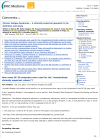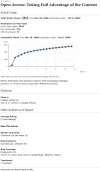Article-level metrics and the evolution of scientific impact
- PMID: 19918558
- PMCID: PMC2768794
- DOI: 10.1371/journal.pbio.1000242
Article-level metrics and the evolution of scientific impact
Abstract
The authors discuss the value of article-level metrics in determining an article's scientific impact.
Conflict of interest statement
The authors have declared that no competing interests exist.
Figures



References
-
- Garfield E. Citation analysis as a tool in journal evaluation. Science. 1972;178:471–479. - PubMed
-
- Bollen J, Rodriquez M. A, Van de Sompel H. Journal status. Scientometrics. 2006;69:669–687.
-
- Bergstrom C. Eigenfactor: measuring the value and prestige of scholarly journals. C&RL News. 2007;68(5)
-
- Bollen J, Van de Sompel H, Hagberg A, Chute R. A principal component analysis of 39 scientific impact measures. PLoS One. 2009;4:e6022. doi: 10.1371/journal.pone.0006022. - DOI - PMC - PubMed
MeSH terms
LinkOut - more resources
Full Text Sources

